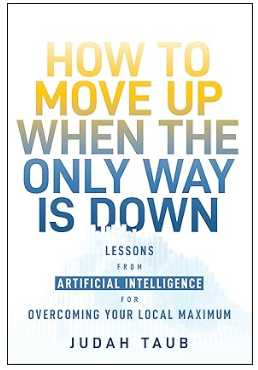 ● How to Move Up When the Only Way is Down: Lessons from Artificial Intelligence for Overcoming Your Local Maximum
● How to Move Up When the Only Way is Down: Lessons from Artificial Intelligence for Overcoming Your Local Maximum
Judah Taub
Interview with author via CTech
Q: What are some of the ways that humans can learn from AI in these instances where humans might metaphorically ‘climb the wrong mountain’? How can humans adopt some of those AI lessons?
A: The key challenge that I’m discussing is the goal of everybody is to reach a higher point, a higher altitude. The higher out point in a field could represent a higher valuation if you’re a startup, or if you’re an individual making more money. These are the very capitalist ones – other things could be more happiness in your life or doing more good. You can define success however you want. And the point is higher up in the field is better, lower down is not as good.
 ● Shareholder Yield: A Better Approach to Dividend Investing (2nd ed.)
● Shareholder Yield: A Better Approach to Dividend Investing (2nd ed.)
Meb Faber
Interview with author via Ritholtz.com
Q: Why should companies that are returning cash to investors through either dividends or buybacks be attractive to investors?
A: There’s a lot of co inherited traits for a company that’s paying dividends or buying back shares. The biggest is they have to have the cash in the first place. So if you’re paying out a 10% yield, then likely you either have a ton of cash flow or more cash than you know what to do with. A good traditional case study would be Apple who did both. They pay out cash dividend and they do a stock buyback. And the summation of the two is really the combination being agnostic, the holistic that matters.
 ● The Fifteen Most Repeated Lies in Business Today: Falsehoods and Half-Truths Told by CEOs and Business Leaders
● The Fifteen Most Repeated Lies in Business Today: Falsehoods and Half-Truths Told by CEOs and Business Leaders
Neil P. McNulty
Summary via publisher (Koehler Books)
Within the world of business and the emerging trends that surround it, many senior executives and business leaders have fallen into a pattern of repeating commonly used phrases and “truths,” often told halfheartedly, without fervor or full confidence. What business leaders say to headhunters in confidential conversations often reveals what they truly believe, and what they say is often at odds with what they and their companies advocate for publicly. What frequently begins as a noble aspiration for a company eventually evolves into an impossibility but is rarely admitted as such.
 ● Savings and Trust: The Rise and Betrayal of the Freedman’s Bank
● Savings and Trust: The Rise and Betrayal of the Freedman’s Bank
Justene Hill Edwards
Review via The Wall Street Journal
It is undoubtedly true, as Ms. Edwards asserts, that the failure of the bank, which had been aggressively marketed in black neighborhoods and churches, caused African-Americans to lose “what little confidence they had” in the white financial establishment. But why exactly did the bank fail? The trustees were shameless in doling out illicit loans, but the average value of unpaid loans, the author says, was only $2,000. Was this enough to break the bank? Callous neglect of the welfare of the black depositors obviously played a part, but Ms. Edwards takes an unfortunate rhetorical turn, framing the failure as an example of “economic violence and terrorism.” At least 100 other banks, with mostly white depositors, failed in the 1873 Depression. It would have been useful to compare their experience with that of Freedman’s. At the very least the author might have noted that, in the 19th century, corporate abuse of conflicts of interest, while shameful, was all too common.
Please note that the links to books above are affiliate links with Amazon.com and James Picerno (a.k.a. The Capital Spectator) earns money if you buy one of the titles listed. Also note that you will not pay extra for a book even though it generates revenue for The Capital Spectator. By purchasing books through this site, you provide support for The Capital Spectator’s free content. Thank you!